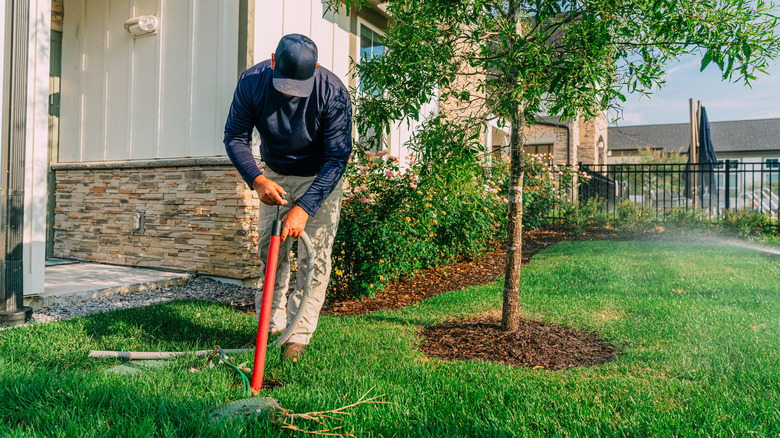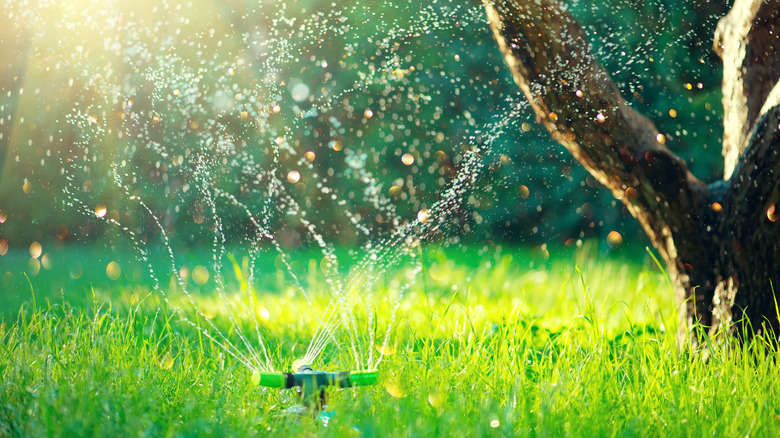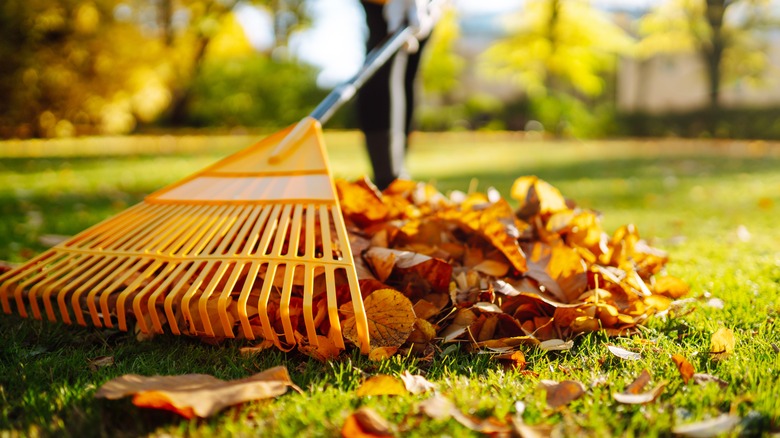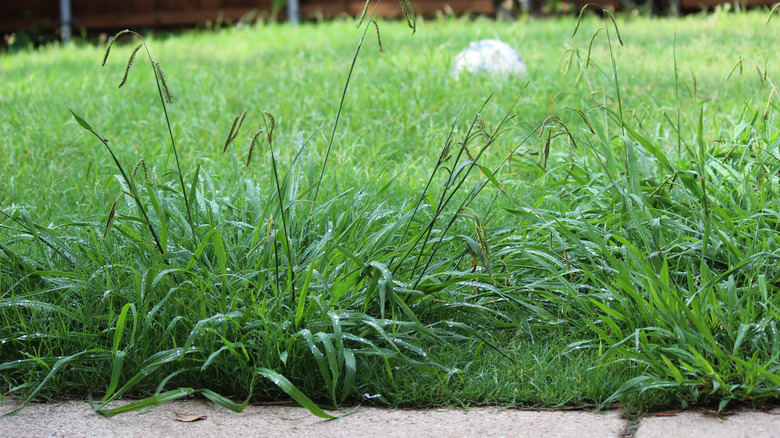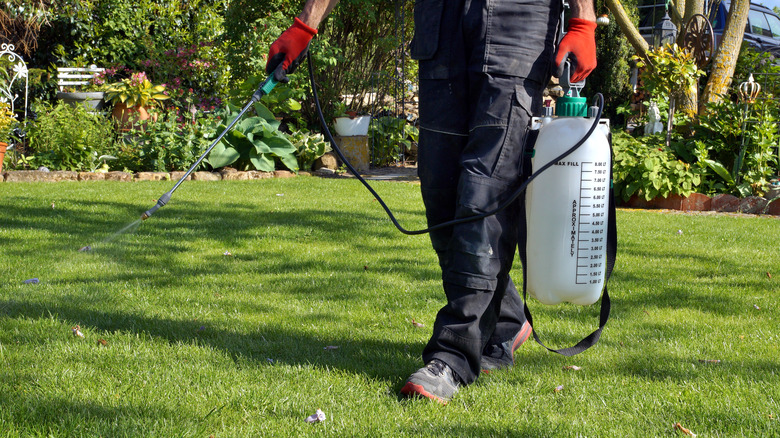Secrets Only Professional Landscapers Know, According To A Lawncare Expert
Taking care of our lawns seems like it should be an easy feat. After all, we grew up watching our dads mow the grass on the weekends, and our mom plant tulip bulbs in the fall, and their yards always seemed to be in great shape — right? Unfortunately, the abundance of lawncare myths leads to a variety of practices that make things more difficult than they appear. So, even though we think we're doing the right thing for our grass, like watering our lawn every day or using salt to kill weeds, in reality, we are doing more harm than good. Sometimes, calling in a professional is the best way to set things straight. They're full of expertise and insights that the average homeowner doesn't have. But what exactly do lawncare professionals know that the average homeowner doesn't?
Outdoor Guide spoke to Rob Palmer, President of the Lawn Squad, who shared some exclusive insights into the secrets of lawncare. Read on to discover tips that only top professionals know so that you can achieve lush, vibrant grass.
Water your lawn deeply, but less often
Homeowners often water their lawn entirely too often — especially during summer. We assume that the sun's rays and summer heat will cause the water to evaporate quickly, so we overcompensate by watering more frequently. However, this can lead to overwatering, which is a major mistake you want to avoid for your garden and your lawn. Overwatering can suffocate the roots of your grass and plants, making it harder for them to receive the nutrients they need to thrive.
Instead of worrying about water evaporating, Palmer advises to "water the lawn deeply and less frequently." Though this seems counterintuitive, it makes sense when you understand soil composition. "Soil temperatures are cooler at lower depths, meaning that lawns can sustain overall warmer surface conditions and [still] thrive throughout the season," explains Palmer. The key is to "water the lawn long enough to allow it to infiltrate and percolate deeper into the soil," Palmer explains, where it won't dry up as quickly because it is not exposed to as much sun or heat.
Palmer recommends watering for "30-45 minutes two to three times per week, instead of watering your lawn for 20 minutes daily" to achieve the best results. This schedule ensures that the water reaches deeper into the soil, promoting healthier root growth and making your lawn more resilient to heat and drought conditions. By following this approach, you can maintain a bright, healthy yard all season long.
Don't rake your lawn aggressively in the spring
After winter, homeowners may notice that sections of their yard tend to matte down. This happens because the weight of snow and ice, combined with the cold temperatures, can compact the soil and press down on the grass. Additionally, freeze-thaw cycles can cause the soil to heave and settle unevenly, leading to patches where the grass appears lifeless.
To spring the grass back up, it can be tempting to rake through these matted areas after the winter. However, Palmer tells us that "raking can damage the softer turf tissue and disturb the soil" if it is done too aggressively, which will leave the grass and soil in vulnerable conditions. Palmer also notes that this could in turn lead to weed germination.
Instead, he recommends simply mowing the lawn or using a leaf blower to avoid the pitfalls of being too aggressive with your rake. This will help the grass aerate and eventually dry out so that it stands back up again. If neither of those methods do the trick, and you feel you must resort to a rake, it is extremely important to be gentle. Do not physically pull up the grass. Instead focus on removing any dead leaves or debris on the surface, so that the grass can be exposed to air, which will help ventilate it. As a bonus, this also serves as a great way to prevent snow mold.
Apply crabgrass pre-emergent before it gets too cold
Crabgrass is a common and aggressive weed that invades many lawns and gardens each year. It germinates and spreads rapidly, often outcompeting desirable grass species and creating unsightly patches in your lawn. To prevent crabgrass from popping up, many homeowners apply crabgrass pre-emergent, an herbicide that stops the growth of this weed in its tracks. It works by creating a chemical barrier on the surface of the soil that inhibits seeds from germinating and growing.
However, there are very specific conditions under which the pre-emergent will function best. According to Palmer, it needs to be timed in relation to the soil's temperature. Specifically, this means applying it to your lawn before soil temperatures consistently reach 55 degrees Fahrenheit. This is the temperature threshold for when crabgrass seeds will initiate germination. As a heads up, Palmer states that "this is typically when the outside temperatures are consistently in the 60s throughout the week."
Target your weeds directly
Getting rid of weeds in your yard can feel like a full-time chore. However, the pros use some tricks of the trade that can make life easier. "The trick to effective weed control is getting the product directly on the target area. Professionals use additives that allow the product to adhere directly to the weeds for the most effective control," Palmer says.
But where can one find such a product? Thankfully, the answer should come as no surprise to those who have completed some yardwork in their day. "These additions are known as spreader stickers and are widely available at garden centers," Palmer says.
Spreader stickers enhance the performance of herbicides by ensuring the active ingredients stick to the weeds' surface and do not wash away or drip off. They contain surfactants that improve adhesion, so that the herbicide can penetrate the plant's cuticle more effectively. This also means that even in heavy rains, the herbicide is less likely to be wasted, maximizing the efficacy of the herbicide and saving you time and money.
